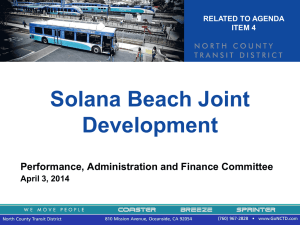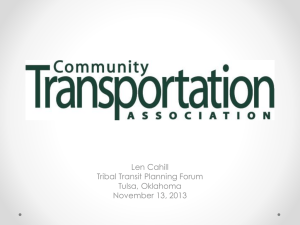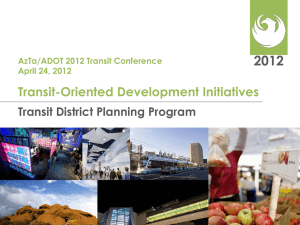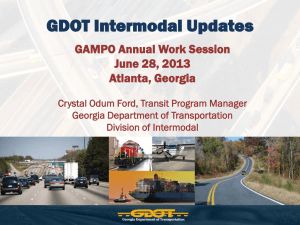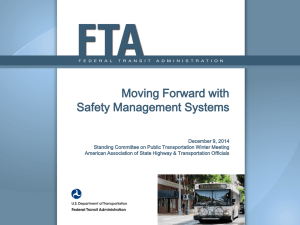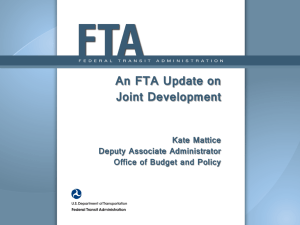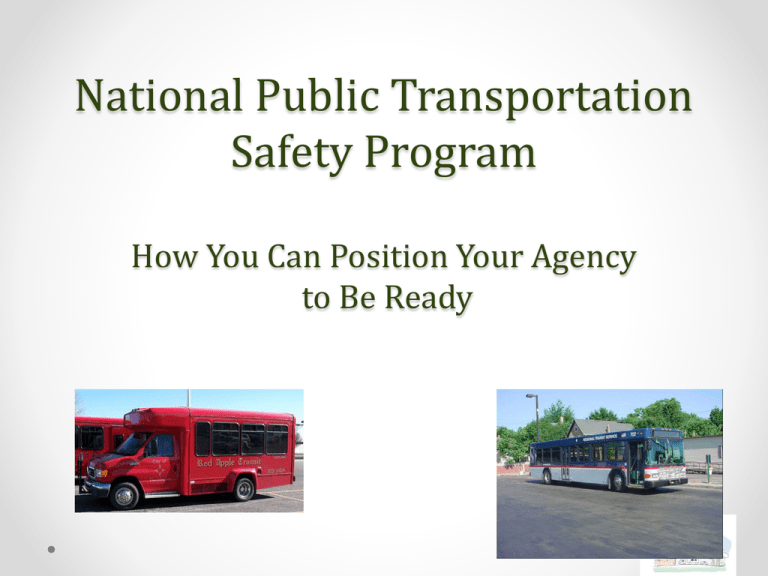
National Public Transportation
Safety Program
How You Can Position Your Agency
to Be Ready
Federal Level
FTA mandated by legislation to develop
1) A National Public Transportation Safety Plan — FTA
has chosen to integrate a Safety Management
System Approach
(first time FTA has had authority over safety since 1964)
2) A Transit Asset Management system
National Public
Transportation Safety Plan
1. Safety performance criteria for all modes of
public transportation
2. Definition of state of good repair,
implemented through national TAM (transit
asset management) system
3. Public transportation safety certification
training program
4. Minimum safety performance standards for
transit vehicles (not regulated through other
federal agency)
National Transit Asset
Management
• FTA defines “state of good repair” w/objective
standards for measuring asset conditions
• FTA establishes performance measures
• FTA recipients/subrecipients must develop an asset
management plan
• Asset inventories, condition assessments, and
performance targets must be reported to FTA
• FTA must provide TA to recipients, including an
analytical process or decision support tool, to
estimate and prioritize capital investment needs
Local Level
• Who:
o Large urbans (>200,000)—develop own plan
o Small urbans/rural recipients of 5307/5311—state can
provide templates/certify plans
o Subrecipients
• What will be required:
o Transit Asset Management plan, with annual SGR
performance targets and reported to NTD
o Transit Agency Safety Plan, using the SMS (Safety
Management System) approach
o Safety and TAM plans incorporated into MPO long-range
plans and TIPs and STIP
Transit Asset
Management Plan
Agencies adopt strategic approach to thinking about
life-cycle of assets and prioritize investment:
• Capital asset inventory (leverage reporting already
done for NTD)
• Condition assessment
• Investment prioritization
• SGR performance targets, based on FTA SGR
definition (direct recipients set for subrecipients)
Community Transportation Association
Transit Agency Safety Plan
Recipient must establish a comprehensive public
transportation agency safety plan to include:
Board or equivalent entity must approve the safety plan
Methods for identifying/evaluating safety risks
Strategies to minimize exposure
Process/timeline for conducting annual safety plan review
Performance targets (safety performance criteria + SGR
standards)
o Safety Officer, reporting to management
o Comprehensive staff training program
o
o
o
o
o
Community Transportation Association
Safety Management
‘Safety Management’ is the systematic and
comprehensive management of the safety
hazards and risks associated with transit system
operations and related maintenance activities to
achieve high levels of safety performance.
Safety Performance Management
Network
Community Transportation
Association
Safety Management Systems
(SMS)
The goal of SMS is to ensure that public transit
agencies have a strategic decision-making
process to proactively identify, prioritize, and
control emerging safety risks before these risks
become critical system failures.
How is Safety defined
in an SMS?
Safety is the state in which the risk of injury to persons
or damage to property is reduced to, and maintained
at or below, an acceptable level through a
continuing process of hazard identification and risk
management.
4 questions that SMS will
facilitate answering
• What is most likely to be the cause of your next
accident or serious incident?
• How do you know that?
• What are you doing about it?
• Is it working?
Slide 12
Key Elements
1) Agree on outcomes critical to safety performance
2) Select metrics for monitoring outcomes
3) Gather baseline data on current conditions
4) Set specific targets—measurable, acceptable,
consistent w/state/fed---and dates for reaching
these targets
5) Collect data regularly to assess if targets are being
met
6) Analyze performance data and reporting results
7) Integrate performance results in decision‐making.
SMS Framework
1. Safety Management Policy
2. Safety Risk Management
3. Safety Assurance
4. Safety Promotion
Community Transportation
Association
Safety Management Policy
• Accountable Executive
• Roles and responsibilities—management and
employee
• Management commitment
• Integration with existing programs
• Safety performance objectives
• Positive safety culture
• Documentation
Safety Risk Management
• Proactively identifying safety hazards
• Evaluating potential consequences of safety
hazards
• Developing risk controls to mitigate consequences
Safety Assurance
• Monitoring individual safety
performance
• Monitoring organizational
safety performance
• Evaluating effectiveness of risk controls
• Measuring if safety objectives are met
• Managing risk involved in change
• Continuously improving SMS
Safety Promotion
• Ensuring organization-wide safety communication
• Training to proficiency on safety skills and
competence
• Training on SMS roles and responsibilities
Benefits of a SMS
• Direct and indirect cost savings due to
accident/loss prevention and reduction in
insurance premiums
• Increased competitive business advantage
through a marketable record of safe
operations
• Logical prioritization of safety needs based on
the level of risk involved
• Continuous improvement of operational and
maintenance processes
Benefits of an SMS
• Demonstrated due diligence when accidents
occur;
• Improved communications and employee
morale – spreads responsibility for safe
operations throughout all levels of org.
• Increased collaboration between stakeholders
on safety initiatives to mitigate risk, especially in
emergency preparedness activities
FTA Support for Bus Safety
Program
Voluntary
Onsite
Reviews
State DOT
Orientation
Seminars
Bus Safety
Program
Website
Industry
Coordination
and
Outreach
FTA Resource Website
• Library of 1,300 resources
• Safety news and events
• Self-assessment tool
(identify safety gaps)
• Case studies (support emergency
planning and decision-making)
• Currently in redesign (w/ E-learning
modules)
• 1,600 registered users, 520,000
downloads of resources
http://bussafety.fta.dot.gov/
Voluntary Onsite Reviews
• Scheduled by request from transit agencies,
state DOTs, FTA regions
• Onsite for 1–3 days
• Voluntary; designed to
provide safety guidance
• Post-visit report and technical
assistance safety materials
• 53 Reviews done to date
• NTD data indicates significant
reduction in accidents
in year after a review
Orientation Seminars
• Co-sponsored by state DOTs / state transit
associations
• Publicizes bus program / encourages attendees
to use program resources
• Provides safety training, guidance, technical
assistance
• Demonstrates Bus Program
website
• Allows dialogue on transit
safety needs
Program Outreach
Initiatives include:
- Presentations
o CTAA EXPOs
o FTA regional
conferences
o National rural
conferences
o MTAP/SCOPT annual
meetings
o Tribal transit conferences
o State transit association
conferences
- Blast emails
- Panels at conferences
- Outreach to transit
associations
2 trainings from CTAA:
Certified Safety and Security Officer (CSSO)
Community Transportation Safety & Security
Accreditation (CTSSA)
Community Transportation Association
CSSO and CTSSA Trainings
As a partner to FTA’s Bus Safety and Security
program, CSSO and CTSSA programs are two-part
process to provide
• Provide education, support, and recognition to
individuals and transit organizations in critical
areas of safety and security.
• Give transit systems a comprehensive set of
tools necessary to meet this critical safety,
security, and emergency preparedness
responsibility and to recognize individual and
agency mission accomplishments.
Community Transportation Association
Certified Safety and Security
Officer (CSSO) Training
offered by Community Transportation Assn. of
America
Community Transportation Association
Certified Safety and
Security Officer (CSSO)
A CSSO is trained to assist
in improving the
preparedness of public
and community
transportation operations,
and to maximize a transit
system’s ability to provide
safe and secure transit.
Community Transportation Association
Certified Safety and
Security Officer (CSSO)
CSSOs
o Review existing system safety
standards
o Identify and address FTA safety
program benchmarks
o Highlight system strengths
o Identify areas for improvement
o Develop a safety, security and
emergency preparedness
program
Community Transportation Association
8 Core Areas of the Training
o
o
o
o
o
o
o
o
System leadership and administration
Transit operations
Maintenance and technology
Personnel management
Training and development
Security initiatives
Safety initiatives
Emergency preparedness
System Self-Assessment Tool
1. If the organization has experienced safety and security incidents related to service design
concerns, it has reacted to help mitigate safety and security risk in the future based on these
incidents.
FINDING:
Standard Met
Improvement needed
Not Applicable
COMMENTS:
1. In its development of specifications, the organization takes into consideration safety and
security issues such as seating configuration, lift placement, and number of unblocked door
exits and emergency window exits for use in evacuating the vehicle in a fire or other life
threatening incident.
FINDING:
Standard Met
Improvement needed
Not Applicable
COMMENTS:
1. The maintenance management function ensures that vehicles are regularly and systematically
inspected and maintained in accordance with a maintenance plan and with the manufacturers’
recommendations and requirements.
FINDING:
Standard Met
COMMENTS:
Community Transportation Association
Improvement needed
Not Applicable
Community Transportation
Safety and Security
Accreditation (CTSSA)
Training
offered by Community Transportation Assn. of
America
Community Transportation Association
Community Transportation Safety and
Security Accreditation (CTSSA)
For CTAA, accreditation is a
process by which community
and public transit systems,
not individuals, are reviewed
to determine whether they
meet certain standards of
quality.
Community Transportation Association
Community Transportation Safety and
Security Accreditation (CTSSA)
This program is designed to
promote the safety and
security of the customers of
community and public
transportation systems…
Community Transportation Association
…and to promote the safety
and security of the women
and men who deliver these
services and provide mobility
for the riding public every
day.
Community Transportation Association
Why is this accreditation
important?
o It reflects the quality by which your organization conducts its
business.
o It speaks to a sense of public trust, as well as high professional
standards
o It provides a publicly recognized badge signifying excellence in,
and commitment to, the safety and security of your passengers
o Accreditation is an extremely positive step in reducing agency
liability and the cost of insurance
o It provides impartial evaluation on a periodic basis by
professional colleagues.
o Accreditation provides assurance to your passengers and the
general public that your transportation system is engaged in
continuous quality review and improvement and that it meets
the Federal Transit Administration – endorsed standards of their
Bus Safety and Security Program.
Community Transportation Association


